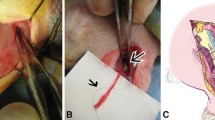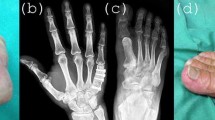Summary
The morphological and physical aspects of cortical bone autografts implanted in dogs for 1–9 months in two differently located skeletal defects are reported with a twofold aim: to provide a reference system for further comparison with various allografts and to delineate a general pattern of cortical bone graft healing. A 3-cm osteoperiosteal gap was created in the diaphyseal segment of the ulna and fibula of mature dogs. The grafts, freed from periosteum and bone marrow, were then inverted and replaced for the autografts in the left limb hone without internal fixation or external splints. On the right side, different allografts were tested. A group of three animals also had an unfilled segmental resection on the right as control. Dogs were observed for 1, 2, 3, 6, and 9 months and were able to bear weight within 3 days. Twenty-eight ulnae and 27 fibulae were available for this autograft study. Fluorochromes were injected at mid-term and at the end of the observation. All the grafts were assessed morphologically by cross-section microradiographs and ultraviolet light microscopy, and a morphometric analysis for porosity and fluorescence was done. To evaluate the physical aspects of graft healing, the recovered ulnar autografts, when available, were submitted to photon absorptiometry and to torsional loading. Morphologically, resorption was found to invade the cortical bone graft transversely through radial tunnels, and in addition to the host-bone-graft junction, the entire transplant surface provided another way for revascularization. The highest porosity level was achieved 2 months after surgery for both ulna and fibula, while new bone formation, as assessed by fluorochromes, was most important at 3 months. At 9 months, porosity remained above the normal range as determined in a set of five nongrafted dogs. While the lack of correlation for porosity between the two grafts suggests that local factors are more important in graft resorption, the observed correlation for fluorescence indicates that new bone deposition is more dependent upon skeletal metabolic activity. Within each graft, porosity and new bone formation were not well correlated. In the ulna, the bone mineral content (BMC) reflected the graft volumetric variations during the remodeling, with the lowest mean value at 3 months. For each graft, BMC was well correlated with the torsional stiffness. When torsionally loaded, the maximal tangential shear stress at failure of the graft was negatively related to its cortical porosity. From this study, it appears that resorption and new bone formation follow the same temporal evolution in two differently located cortical bone autografts when expressed in terms of porosity and fluorescence. Nine months after implantation, the graft healing remains incomplete. Porosity, reflecting the state of intracortical repair, emerges as a critical factor in graft torsional strength.
Similar content being viewed by others
References
Albrektsson B (1971) Repair of diaphyseal defects. Thesis, University of Goteberg
Albrektsson T (1979) Healing of bone grafts. Thesis, University of Goteborg
Anderson KJ, Fry LR, Clawson K, Sakurai O (1965) Experimental comparison of autogenous, homogenous, and heterogenous bone grafts: a planimetric measurement study. Ann Surg 161:263–271
Bos GD, Goldberg VM, Powell AE, Heiple KG, Zika JM (1983) The effect of histocompatibility matching on canine frozen bone allografts. J Bone Joint Surg [Am] 65:89–96
Burchardt H, Jones H, Glowczewskie F, Rudner G, Enneking WF (1978) Freeze-dried allogeneic segmental cortical bone grafts in dogs. J Bone Joint Surg [Am] 60:1082–1090
Burr DB, Martin RB (1983) The effects of composition, structure and age on the torsional properties of the human radius. J Biomech 16:603–608
Burwell RG (1969) The fate of bone grafts. In: Appley AG (ed) Recent advances in orthopaedics. Churchill, London, pp 115–207
Cameron JR, Sorenson J (1963) Measurement of bone mineral in vivo: an improved method. Science 142:230–232
Coutelier L, Delloye Ch, De Nayer P, Vincent A (1984) Aspects microradiographiques des allogreffes osseuses massives chez l'homme. Rev Chir Orthop 70:581–588
Davis PK, Mazur JM, Coleman GN (1982) A torsional strength comparison of vascularized and nonvascularized bone grafts. J Biomech 15:875–880
De Marneffe R (1951) Recherches morphologiques et expérimentales sur la vascularisation osseuse. Acta Chir Belg 9:681–704
Dhem A (1967) Le remaniement de l'os adulte. Thesis, Arscia, Brussels
Enneking WF, Burchardt H, Puhl JJ, Thornby Y (1972) Temporal and spatial activity in mirror segments of mature dog fibulae. Calcif Tissue Res 9:283–295
Enneking WF, Burchardt H, Puhl JJ, Piotrowski G (1975) Physical and biological aspects of repair in dog corticalbone transplants. J Bone Joint Surg [Am] 57:237–252
Friedlaender GE (1982) Bone-banking. Current concepts review. J Bone Joint Surg [Am] 64:307–311
Heiple KG, Chase SW, Herndon CH (1963) A comparative study of the healing process following different types of bone transplantation. J Bone Joint Surg [Am] 45:1593–1616
Holden CEA (1972) The role of blood supply to soft tissue in the healing of diaphyseal fractures. An experimental study. J Bone Joint Surg [Am] 54:993–1000
Holmstrand K (1957) Biophysical investigations of bone transplants and bone implants — an experimental study. Acta Orthop Scand [Suppl] 26
Horsman A, Currey JD (1983) Estimation of mechanical properties of the distal radius from bone mineral content and cortical width. Clin Orthop 176:298–304
Inclan A (1942) The use of preserved bone graft in orthopaedic surgery. J Bone Joint Surg 24:81–89
Kreuz FP, Hyatt GW, Turner TC, Bassett, CAL (1951) The preservation and clinical use of freeze-dried bone. J Bone Joint Surg [Am] 33:863–883
Laflamme GH, Wahner HW, Jowsey J (1972) Photon absorptiometry: use in experimental bone turnover study. J Nucl Med 13:593–598
Mazess RB (1983) The noninvasive measurement of skeletal mass. In: Peck WA (ed) Bone and mineral research, vol 1. Excerpta Medica, Amsterdam pp 223–279
McLean FC, Rowland RE (1963) Internal remodeling of compact bone. In: Sognnaes RF (ed) Mechanisms of hard tissue destruction. American Association for the Advancement of Science, Washington, DC, pp 371–383
Naimark A, Mitler K, Segal D, Kossoff J (1981) Nonunion. Skeletal Radiol 6:21–25
Nielsen HE, Mosekilde L, Mosekilde L, Melsen B, Christensen P, Olsen KJ, Melsen F (1980) Relations of bone mineral content, ash weight and bone mass: implications for correction of bone mineral content for bone size. Clin Orthop 153:241–247
Olerud S, Danckwardt-Lilliestrom G (1971) Fracture healing in compression osteosynthesis. An experimental study in dogs with an avascular diaphyseal intermediate fragment. Acta Orthop Scand [Suppl] 137
Paavolainen P (1978) Studies on mechanical strength of bone. I. Torsional strength of normal rabbit tibio-fibular bone. Acta Orthop Scand 49:497–505
Panjabi MM, White III AA, Southwick WO (1973) Mechanical properties of bone as a function of rate of deformation. J Bone Joint Surg [Am] 55:322–330
Pelker RR, Friedlaender GE and Markham TC (1983) Biomechanical properties of bone allografts. Clin Orthop 174:54–57
Ponlot R (1960) Le radiocalcium dans l'étude des os. Arscia, Brussels
Puhl JJ, Piotrowski G, Enneking WF (1972) Biomechanical properties of paired canine fibulas. J Biomech 5:391–397
Reynolds F, Oliver D, Ramsey R (1951) Clinical evaluation of the merthiolate bone bank and homogenous bone grafts. J Bone Joint Surg [Am] 33:873–883
Rhinelander FW (1968) The normal microcirculation of diaphyseal cortex and its response to fracture. J Bone Joint Surg [Am] 50:784–800
Ruff CB, Hayes WC (1984) Bone mineral content in the lower limb. Relationship to cross-sectional geometry. J Bone Joint Surg [Am] 66:1024–1031
Sedlin ED, Hirsch C (1966) Factors affecting the determination of the physical properties of femoral cortical bone. Acta Orthop Scand 37:29–48
Snedecor GW, Cochran WG (1980) Statistical methods, 7th edn. Iowa State University Press, Ames
Stringa G, Mignani G (1967) Microradiographic investigation of bone grafts in man. Acta Orthop Scand [Suppl] 99
Stromberg L, Dalen N (1976) The influence of freezing on the maximum torque of long bones. An experimental study on dogs. Acta Orthop Scand 47:254–256
Stromberg L, Dalen N (1976) Experimental measurement of maximum torque of long bones. Acta Orthop Scand 47:257–263
Terjesen T (1984) Bone healing after metal plate fixation and external fixation of the osteotomized rabbit tibia. Acta Orthop 43:23–35
Urist MR, McLean FC (1950) Bone repair in rats with multiple fractures. Am J Surg 80:685–690
Urist MR, Mikulski A, Boyd SD (1975) A chemosterilized antigen-extracted autodigested alloimplant for bone banks. Arch Surg 110:416–428
Vincent J (1955) Recherches sur la constitution de l'os adulte. Thesis, Arscia, Brussels
Waris P (1981) Healing of cortical and cancellous bone grafts after rigid plate fixation. An experimental study on rabbits. Thesis, University of Helsinki
White III AA, Panjabi MM, Hardy R (1974) Analysis of mechanical symmetry in rabbit long bones. Acta Orthop Scand 45:328–336
Wilson PD (1951) Follow-up study of the use of refrigerated homogenous bone transplants in orthopaedic operations. J Bone Joint Surg [Am] 33:307–323
Yu WY, Siu CM, Shim SS, Hawthorne HM, Dunbar JS (1975) Mechanical properties and mineral content of avascular and revascularizing cortical bone. J Bone Joint Surg 57:692–695
Zucman P, Maurer P, Berbesson C (1968) The effect of autografts of bone and periosteum in recent diaphyseal fractures. J Bone Joint Surg [Br] 50:409–422
Trueta J (1966) Nonunion of fractures. Clin Orthop 43:23–35
Author information
Authors and Affiliations
Rights and permissions
About this article
Cite this article
Delloye, C., Coutelier, L., Vincent, A. et al. Canine cortical bone autograft remodeling in two simultaneous skeletal sites. Arch. Orth. Traum. Surg. 105, 79–99 (1986). https://doi.org/10.1007/BF00455843
Received:
Issue Date:
DOI: https://doi.org/10.1007/BF00455843




